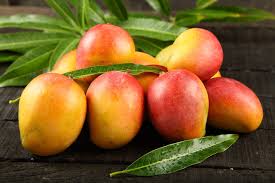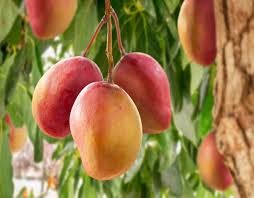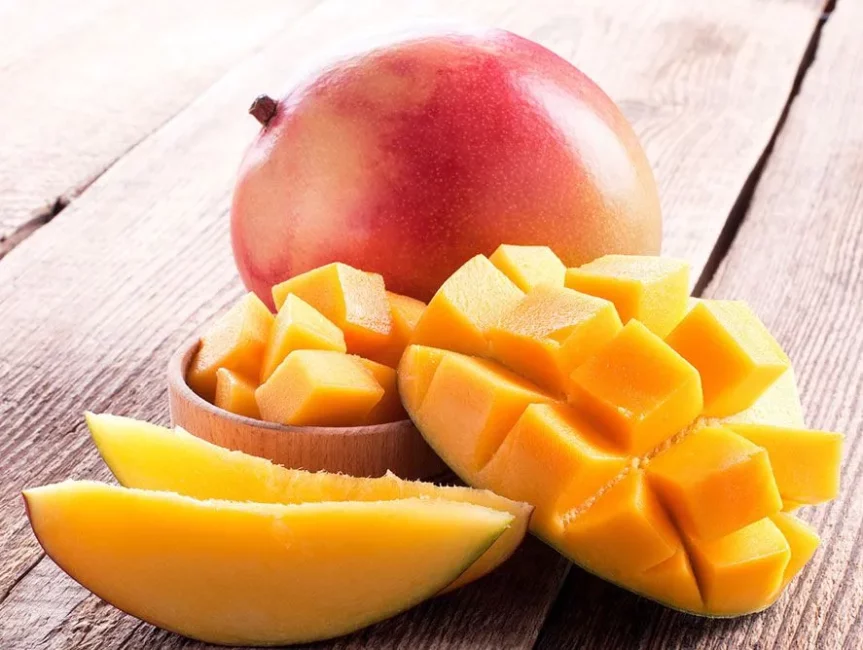Mangoes fruit which is scientifically known as Mangifera indica are delicious fruits that many people around the world enjoy. These fruits come in various shapes, sizes, and colors, making them not only tasty but also visually appealing. With a smooth, sweet taste and a juicy texture, mangoes are a popular choice for snacks, desserts, and even beverages.
One of the remarkable aspects of mangoes is their versatility. You can eat them fresh, slice them into salads, or blend them into smoothies. The natural sweetness of mangoes adds a delightful flavor to any dish they are a part of. Many cultures incorporate mangoes into their traditional cuisines, showcasing the global popularity of this fruit.
The vibrant yellow or orange hue of ripe mangoes is not only visually appealing but also indicative of their ripeness. When selecting a mango, a gentle squeeze can help determine its readiness to be eaten. A ripe mango gives slightly under pressure, signaling that it’s ready to be enjoyed.
Mangoes are not only tasty but also packed with nutrients. They are a rich source of vitamins, including vitamin C, vitamin A, and vitamin E. These vitamins contribute to the overall health of the body, supporting the immune system and promoting healthy skin. Additionally, mangoes contain dietary fiber, aiding in digestion and promoting a feeling of fullness.
The cultivation of mangoes is an art in itself. These fruits thrive in tropical climates, where warm temperatures and well-drained soil provide an ideal environment for their growth. Mango trees can be found in various countries, each region producing mangoes with unique flavors and characteristics. The careful cultivation of mangoes involves proper care, pruning, and harvesting techniques to ensure a bountiful yield.
In many cultures, mangoes are not just fruits but symbols of abundance and prosperity. They are often associated with festivals and celebrations, where people come together to share the joy of this delectable fruit. Mango festivals are common in regions where these fruits are abundantly grown, showcasing different varieties and culinary creations centered around mangoes.
The journey of a mango from the tree to the table involves careful handling and transportation. The delicate nature of ripe mangoes requires attention to prevent bruising or damage during transit. Once they reach their destination, mangoes become a delightful addition to various dishes or a refreshing snack on a hot day.
Mangoes also play a role in the beverage industry. Mango juices, smoothies, and shakes are popular choices for those looking to savor the unique taste of this tropical fruit in a liquid form. The sweet and tangy flavor of mangoes adds a refreshing twist to drinks, making them a favorite among both adults and children.
In addition, mangoes are more than just fruits; they are a delightful experience for the senses. From their sweet and juicy taste to their vibrant colors, mangoes bring joy to people all around the world. Whether eaten fresh, incorporated into dishes, or enjoyed as a beverage, the versatile mango remains a beloved fruit, contributing to the rich tapestry of global culinary delights.
Read Also: Recommended Feed Formula for Piglets (Baby Pigs)
The History of Mangoes (Mangifera indica)

The history of mangoes is a tale that spans centuries, weaving through diverse cultures and regions. Believed to have originated in South Asia, specifically in present-day India and Myanmar, mangoes have a rich historical significance.
Historical records suggest that mango cultivation dates back over 4,000 years. The fruit was not only valued for its taste but also held symbolic importance in various ancient civilizations. In Hinduism, for instance, the mango is considered a sacred fruit, often associated with gods and goddesses. It is mentioned in ancient Indian texts and scriptures, highlighting its cultural and religious significance.
The spread of mangoes across the globe can be traced to the Silk Road, where traders and explorers introduced this exotic fruit to different parts of the world. The Persians and Arabs played a crucial role in disseminating mango cultivation, bringing the fruit to the Middle East and North Africa. From there, it found its way to Europe through trade routes, making its mark in the Mediterranean region.
The Portuguese explorers are credited with introducing mangoes to the Americas during the 16th century. They planted mango trees in Brazil, and from there, the fruit gradually spread to other parts of the continent. The favorable climate in tropical and subtropical regions of the Americas proved conducive to mango cultivation, resulting in the establishment of thriving mango orchards.
In the 19th century, mangoes made their way to the United States, primarily through the efforts of horticulturists and enthusiasts who recognized the potential for mango cultivation in the warm climates of Florida and California. Today, these states are key contributors to the American mango production.
Throughout history, mangoes have not only been a culinary delight but also a symbol of wealth, abundance, and hospitality. In many cultures, offering a mango is considered a gesture of goodwill and generosity. The fruit’s popularity is not limited to its taste; it is deeply embedded in cultural practices, folklore, and traditions.
Mango varieties have evolved over time through selective breeding and cultivation practices. Different regions have developed their unique types of mangoes, each with distinct flavors, sizes, and colors. The diversity in mango varieties reflects the adaptability and versatility of the fruit, adapting to various climates and soil conditions.
In recent years, efforts to preserve and document different mango varieties have gained momentum. Organizations and agricultural researchers work towards conserving the genetic diversity of mangoes, ensuring the continuation of this fruit’s rich heritage for generations to come.
The history of mangoes is a captivating journey that spans continents and epochs. From its origins in South Asia to its global presence today, the mango has left an indelible mark on the cultural, religious, and culinary landscapes of diverse societies. The story of mangoes continues to unfold, with each juicy bite carrying the echoes of a history that stretches back thousands of years.
The Nutritional Values of Mangoes (Mangifera indica)

Mangoes are not only delicious but also pack a nutritional punch. They are a rich source of essential vitamins, minerals, and antioxidants that contribute to overall health. Here’s a glimpse into the nutritional values of mangoes:
1. Vitamins:
Vitamin C: Mangoes are an excellent source of vitamin C, known for its immune-boosting properties and role in collagen formation.
Vitamin A: Mangoes are high in vitamin A, supporting vision health, skin integrity, and immune function.
Vitamin E: This antioxidant vitamin in mangoes helps protect cells from damage and supports skin health.
2. Minerals:
Potassium: Mangoes contain potassium, which is essential for maintaining proper fluid balance, nerve function, and muscle contractions.
Magnesium: This mineral in mangoes plays a role in various physiological functions, including muscle and nerve function.
3. Dietary Fiber: Mangoes are a good source of dietary fiber, promoting digestive health and helping to prevent constipation.
4. Antioxidants:
Carotenoids: Mangoes contain carotenoids such as beta-carotene, which have antioxidant properties that help protect cells from oxidative stress.
5. Calories and Natural Sugars: While mangoes contain natural sugars, they are relatively low in calories. Moderation is key for those mindful of calorie intake.
6. Phytochemicals: Mangoes contain various phytochemicals that contribute to their vibrant color and may have potential health benefits.
7. Water Content: Mangoes have a high water content, contributing to hydration and aiding in maintaining electrolyte balance.
It’s important to note that while mangoes offer numerous health benefits, individuals with certain medical conditions, such as diabetes, should be mindful of their overall sugar intake, even from natural sources. As with any food, enjoying mangoes as part of a balanced diet is key to reaping their nutritional rewards.
Incorporating mangoes into your diet not only adds a burst of flavor but also provides a range of nutrients that support overall well-being. As with any dietary choices, it’s advisable to enjoy mangoes in moderation and as part of a diverse and balanced diet to ensure optimal nutritional intake.
Read Also: 9 Ways to Fatten Up your Pigs the Right Way
Health Benefits of Mangoes (Mangifera indica)

Mangoes offer a range of health benefits due to their rich nutritional profile. Here are some key health benefits associated with consuming mangoes:
1. Immune System Support: The high vitamin C content in mangoes supports the immune system, helping the body defend against infections and illnesses.
2. Eye Health: Mangoes are a good source of vitamin A and carotenoids, promoting eye health and potentially reducing the risk of age-related macular degeneration.
3. Digestive Health: The dietary fiber in mangoes aids digestion, helps prevent constipation, and supports a healthy gut microbiome.
4. Skin Health: The combination of vitamins A, C, and E in mangoes contributes to healthy skin by promoting collagen production and protecting against oxidative stress.
5. Hydration: With a high water content, mangoes contribute to overall hydration, essential for various bodily functions.
6. Heart Health: The potassium in mangoes helps regulate blood pressure, contributing to heart health and reducing the risk of cardiovascular diseases.
7. Antioxidant Protection: Mangoes contain antioxidants, including quercetin, beta-carotene, and other phytochemicals, which help protect cells from oxidative stress.
8. Weight Management: Despite their natural sugars, mangoes are relatively low in calories and high in fiber, making them a satisfying and nutritious snack that may aid in weight management.
9. Bone Health: The presence of vitamin K and small amounts of calcium and phosphorus in mangoes contributes to bone health.
10. Alkalizing Properties: Mangoes have alkalizing properties, which may help balance the body’s pH levels and support overall health.
It’s important to note that while mangoes offer these health benefits, moderation is key. Like any fruit, they should be part of a well-balanced diet. Additionally, individuals with specific health conditions, such as diabetes, should monitor their overall sugar intake, even from natural sources like mangoes.
Incorporating mangoes into a diverse and balanced diet can be a delicious way to enjoy their health-promoting properties. As with any dietary considerations, it’s advisable to consult with a healthcare professional for personalized advice based on individual health needs and conditions.
How to Grow Mangoes (Growing Guide)
Growing mangoes can be a rewarding experience, but it’s important to consider the tropical nature of these trees. Here’s a basic guide on how to grow mangoes:
1. Climate: Mangoes thrive in tropical and subtropical climates. They require warm temperatures, with the ability to withstand brief periods of cooler weather. In the United States, mangoes are commonly grown in Florida, California, and parts of Hawaii.
2. Soil: Well-draining soil is crucial for mango trees. They prefer slightly acidic to neutral soil. Sandy loam or loamy soil types are ideal. Good drainage helps prevent root rot.
3. Planting: Choose a sunny location for planting, as mango trees require full sunlight for optimal growth. Plant young mango trees during the warmer months, allowing them to establish before colder weather arrives.
4. Watering: While mango trees are somewhat drought-tolerant once established, regular watering is essential during the growing season. Water deeply but allow the soil to dry out between waterings.
5. Fertilization: Mango trees benefit from regular fertilization. Use a balanced fertilizer with additional micronutrients. Apply fertilizer during the growing season, tapering off in the fall and winter.
6. Pruning: Prune young trees to encourage a strong, scaffold-like structure. Once established, minimal pruning is needed. Remove dead or diseased branches as necessary.
7. Mulching: Apply a layer of organic mulch around the base of the tree to conserve moisture, suppress weeds, and regulate soil temperature.
8. Pest and Disease Control: Keep an eye out for common pests like aphids, scale insects, and mango fruit flies. Use appropriate insecticides if needed. Fungal diseases like anthracnose can affect mangoes. Prune affected branches and use fungicides as preventive measures.
9. Harvesting: Mangoes typically take a few years to start fruiting. Once the tree begins producing fruit, harvest when the mangoes are mature but still firm. Ripening can occur off the tree.
10. Cautions: Mango sap and skin may cause irritation in some individuals. Handle with care and wear gloves if necessary. Be mindful of the tree’s size at maturity. Plant it where it has sufficient space to grow.
Remember that growing mangoes may require adjustments based on local conditions. Consult with local horticulture experts or extension services for guidance specific to your region. Additionally, selecting a mango variety suited to your climate can significantly impact your success in growing these delicious fruits.
Read Also: 10 Reasons Why Food Workers Should Keep Garbage Cans Clean and Free of Buildup
